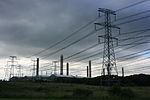Cresswell radar station

Cresswell radar station (also known as RAF Cresswell), was a Chain Home Low (later a Chain Home Extra Low) Second World War radar site at Cresswell, in Northumberland, England. The radar site was south of the village of Cresswell on the road towards Lynemouth and each site occupied a different side of the road. The site was opened by early 1940 and was staffed by Royal Air Force personnel from No. 60 Group, who were accommodated at Lynemouth instead of being billeted at the radar site. Cresswell radar site was known to be poorly located as it did not have enough of a significant elevation above sea level to provide sufficient warning of approaching aircraft. Since closure c. 1945, both sites have been demolished and nothing remains of either site.
Excerpt from the Wikipedia article Cresswell radar station (License: CC BY-SA 3.0, Authors, Images).Cresswell radar station
West Market Street,
Geographical coordinates (GPS) Address Nearby Places Show on map
Geographical coordinates (GPS)
| Latitude | Longitude |
|---|---|
| N 55.226 ° | E -1.528 ° |
Address
England Coastal Path
West Market Street
NE61 5SZ , Lynemouth
England, United Kingdom
Open on Google Maps










